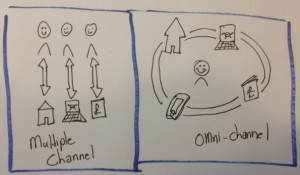I’ve always found it interesting that through all the complexities in this world we can often boil so many varying subjects and areas down to the same few principles.
One of those principles that seem to be pop up in all facets of life and business is Pareto’s principle, more famously known as the 80/20 rule. For those not familiar it’s essentially states that, for many events, roughly 80% of the effects come from 20% of the causes. More generally, this is the observation that most things in life are not distributed evenly.
For example:
- 80% of your time is spent dealing with 20% of your problems
- 80% of your stock comes from 20% of your suppliers
- 20% of your workforce creates 80% of the result
These are interesting, but the one that’s been playing on my mind recently through all my contact with many of the UK’s largest luxury retailers is that roughly 80% of sales come from approximately 20% of their customers. This insight is an aggregate based on multiple conversations and a post on Loyality360.org, but if you’re in retail or have a job in CRM I’m sure you won’t disagree.
So, it’s this instance of the Pareto’s principle that got me thinking. If 80% of sales are coming from 20% of the customers, then who are these 20%, and how can retailers shift the 80% to become more like the 20%?
A common misconception with the 80/20 rule is that the numbers 20 and 80 must add to 100 — they don’t! And why is that important? Well, if we could identify ‘who’ these 20% were and how we could make the 80% more like the 20% then surely we could increase overall revenue?
Think about it. You have 100 customers with total revenue of £10,000. Twenty of these shoppers account for a total £8,000, so £400 each on average and the other eighty shoppers spend an average of £25 each. Now if we could convert just 10% of the shoppers who spend £25 each to shoppers that spend an average of £200 each then we’d have a total revenue of £11,600, up 18%.
So the question lies in understanding the common thread of the 20%. And yes, I’m sure research will show that these 20% on average are more affluent, but there’s also good data that shows shoppers using multiple channels spend a bunch more than single channel shoppers. In fact, CIO/COO Mike Rodgers from Saks was quoted at a Cross Talk conference in a RIS news article in mid 2013 saying, “Saks shoppers who buy in multiple channels spend three to four times as much as customers who are active in only a single channel.
If the above is true, then surely the question should be; how do we get people shopping across multiple channels? The obvious answer seems to be; have a presence across multiple channels and they will come…if only it was that easy.
See, here’s why I believe the terms omnichannel and multi-channel are so often confused. In order to create true omnichannel experiences you need to have multiple channels, however you don’t require omnichannel customers to have multiple channels. See the difference between multi-channel and omnichannel is that in multi-channel, all channels are available to the consumer but are not themselves integrated. In an omnichannel experience, all the channels themselves are connected and the consumers are at the centre of the experience. This sketch should hopefully easily explain the difference:
Back to my original point, if retailers want to convert their customers into shoppers that shop across multiple channels, that ultimately spend more, they need to create omnichannel experiences. True omnichannel experiences take shoppers from their current channel of choice and seamlessly chaperon them within a brand experience through digital and physical worlds, with a customer not knowing (or necessarily caring) where one channel started and the other finished.
The problem is that creating this seamless experience for customers requires work, and lots of it. It takes courage for brands to think beyond the seasons’ sell-though; it takes vision for them to predict tomorrow’s trends; but more than anything it takes effort to be at the forefront on customer experience. Hang on; I’m feeling the application of Pareto’s principle coming on…could going omnichannel mean that retailers get a better handle on who their 20% most valuable customers are and enable them to better able to focus their attention on the customers that matter? Or perhaps it means that they’re able to better know how to motivate the 80% who don’t spend as much? However you choose to look at it, omnichannel means identification, because to do it correctly requires tight data integration and knowing something about your customer personally to tie their experiences together.

